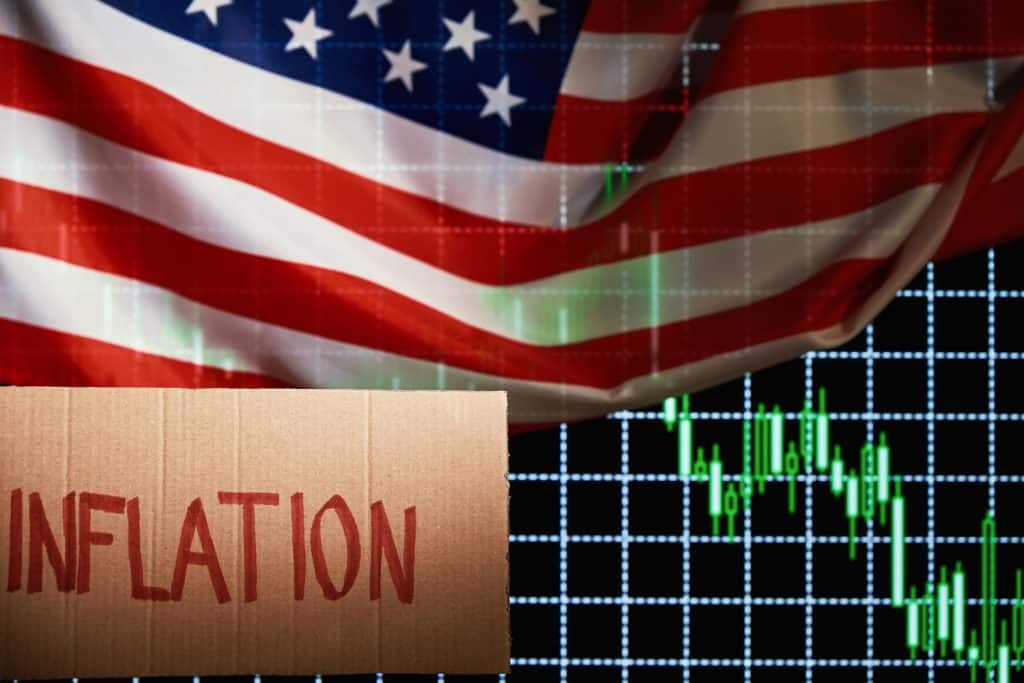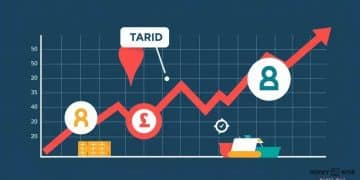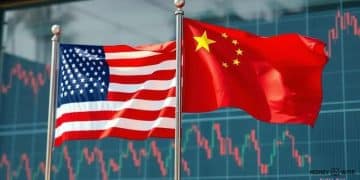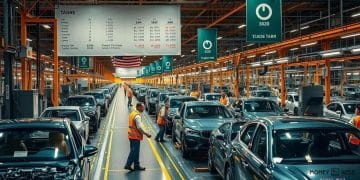Tariff-induced inflation risks and their impacts

Tariff-induced inflation risks arise when tariffs increase production costs, leading to higher consumer prices, and businesses must adapt by diversifying suppliers and optimizing pricing strategies to mitigate impacts.
Tariff-induced inflation risks can have sweeping effects on everyday life. Have you noticed rising prices at your local grocery store? That’s just one way these risks might impact your pocketbook. Let’s explore how tariffs influence inflation and what it means for you.
Understanding tariff-induced inflation
Understanding tariff-induced inflation is essential to grasping how tariffs can impact the economy. When governments impose tariffs, they increase the cost of imported goods. This can lead to higher prices for consumers, affecting everyday life in noticeable ways.
Using tariffs is a common strategy to protect domestic industries, but it can also lead to unintended consequences. The way tariffs apply to goods can create a ripple effect throughout the economy.
How do tariffs affect pricing?
When prices rise, it’s often due to tariffs. Businesses pass on the extra costs to consumers, which can adjust how families budget for necessities. This inflation can create hardships, especially for low-income households.
Key factors to consider:
- Increased costs for importing goods.
- Reduced competition leading to higher prices.
- Potential for retaliatory tariffs from other countries.
As prices increase due to tariffs, spending patterns may shift. Consumers could opt for cheaper alternatives or reduce their overall spending. For example, if imported electronics become too expensive, individuals might buy domestic brands, even if they are less preferred.
This shift is critical. It doesn’t only affect individuals but also impacts businesses and economic growth. A rise in prices can lead to decreased consumer demand, which may slow production and lead to job losses in certain sectors.
The broader economic impact
Furthermore, tariff-induced inflation can have long-term repercussions. Inflation could lead to instability in financial markets, causing uncertainty for investors. When inflation rates rise, central banks may respond by adjusting interest rates, impacting borrowing and spending.
It’s a complex cycle where tariffs, inflation, and economic health are deeply intertwined. As a result, understanding these dynamics is crucial for consumers and policymakers alike.
Historical examples of tariff effects
Historical examples of tariff effects provide important insights into how tariffs have shaped economies over time. Analyzing these cases helps us understand the potential consequences of modern tariff policies.
One notable instance is the Smoot-Hawley Tariff Act of 1930 in the United States. This legislation raised tariffs on numerous imported goods, intending to protect American industries during the Great Depression. However, it led to significant retaliation from other countries, resulting in a steep decline in international trade.
Key outcomes of the Smoot-Hawley Tariff:
- Increased prices for consumers as imported goods became more expensive.
- Job losses in export-oriented industries.
- Retaliation tariffs from other nations, worsening the global economic situation.
Another historical example is the U.S. tariffs on steel and aluminum in 2018. These tariffs aimed to protect domestic production but also sparked tensions with trading partners. Countries affected by these tariffs responded with their own retaliatory tariffs, impacting various sectors.
Consequences of the steel and aluminum tariffs:
- Rising costs for manufacturers relying on these materials.
- Job cuts in industries dependent on steel and aluminum imports.
- Increased prices for consumers on goods made with these metals.
These examples illustrate how the fallout from tariffs can extend far beyond initial intentions. While they may protect specific industries, tariffs often lead to broader economic challenges, including reduced trade and increased prices for consumers.
By examining historical precedents, we gain a clearer perspective on the implications of tariff-induced inflation and how it affects global relations and economic health.
Economic theories behind inflation risks
Economic theories behind inflation risks help us understand how and why prices rise in an economy. These theories explore various factors that contribute to inflation and the implications of tariff-induced inflation specifically.
One common theory is the cost-push inflation concept. This occurs when the costs of production increase, leading businesses to raise prices. Tariffs can be a significant driver of this type of inflation, as they increase the cost of imported goods and materials.
Key factors influencing cost-push inflation:
- Higher tariffs on imports raise costs.
- Increased wages for workers can drive production costs up.
- Supply chain disruptions that affect material availability.
Another important theory is demand-pull inflation. This happens when demand exceeds supply, causing prices to rise. In some cases, tariffs can create shortages of goods, pushing demand higher and leading to increased prices. When consumers cannot find the products they want, their willingness to pay more can fuel inflation further.
Examples of demand-pull inflation:
- Surge in demand for essential goods during crises.
- Limited supply of raw materials due to tariffs.
- Increased disposable income leading to higher spending.
Additionally, the monetary policy theory influences inflation risks. Central banks may adjust interest rates to control inflation. When tariffs create uncertainty, it can affect economic expectations, leading central banks to act cautiously. Low interest rates may stimulate the economy, but they can also contribute to higher inflation if not managed carefully.
Understanding these economic theories allows us to see the broader picture of how tariffs and inflation interact. Each factor plays a distinct role, shaping the economic landscape and impacting consumers and businesses alike.
Mitigating strategies for businesses
Mitigating strategies for businesses are essential in navigating the challenges posed by tariff-induced inflation. As prices rise, companies must adapt to maintain their competitiveness and profitability.
One effective strategy is to diversify suppliers. By sourcing materials and products from multiple countries, businesses can reduce dependency on any single market. This approach helps to minimize risks associated with tariffs and can provide cost advantages.
Benefits of supplier diversification:
- Improved resilience against price fluctuations.
- Increased leverage in negotiations with suppliers.
- Access to a wider range of products and materials.
Another important tactic is to optimize pricing strategies. Businesses can conduct market research to understand consumer price sensitivity. By adjusting pricing models, they can find the balance between maintaining sales volume and ensuring profitability even when costs rise.
Examples of pricing strategies include:
- Implementing dynamic pricing based on market demand.
- Offering tiered pricing or discounts to attract price-sensitive customers.
- Communicating value clearly to justify price increases.
Investing in technology can also play a crucial role in mitigating inflation risks. By leveraging advanced analytics and forecasting tools, companies can better predict market trends and adjust their operations accordingly. Enhanced operational efficiency can help to counteract rising costs.
Additionally, building strong relationships with stakeholders, such as suppliers and customers, proves beneficial. Open lines of communication can lead to collaborative problem-solving during times of economic uncertainty.
Ultimately, businesses that adopt these mitigating strategies are better positioned to navigate the complexities of tariff-induced inflation and maintain stability in their operations.
Future outlook on tariffs and inflation
Future outlook on tariffs and inflation remains uncertain as global markets continue to evolve. Understanding this outlook is essential for businesses and consumers alike.
One key trend is the possibility of increasing protectionist measures. Many countries are implementing tariffs to shield local industries from foreign competition. This can lead to rising prices for consumers and could potentially spark trade wars, which can further complicate the inflation landscape.
Factors influencing future tariffs include:
- Changes in government policies and leadership.
- Shifts in public sentiment regarding globalization.
- Economic conditions and recovery trends after global crises.
Another significant aspect is the evolving nature of global supply chains. Businesses are recognizing the risks associated with relying heavily on imports and are seeking more resilient supply networks. This adjustment is likely to shape future tariff policies, potentially leading to a push for localized production.
How supply chain changes could affect inflation:
- Increased production costs if companies shift to domestic sources.
- Emerging trends in sustainable production practices.
- Variability in pricing based on the availability of resources.
Additionally, technological advancements may play a role in mitigating inflation. Innovations in logistics and production efficiencies could help businesses manage costs. As companies adopt new technologies, there may be less need to pass increases onto consumers, which can help stabilize prices.
Overall, the future of tariffs and inflation will likely be shaped by a combination of political, economic, and technological factors. Monitoring these elements closely can provide insights into how businesses prepare for potential changes in the market.
FAQ – Frequently Asked Questions about Tariff-Induced Inflation Risks
What are tariff-induced inflation risks?
Tariff-induced inflation risks refer to the potential for prices to rise due to tariffs imposed on imported goods, which increase production costs and consumer prices.
How can businesses mitigate the impact of tariffs on inflation?
Businesses can mitigate tariff impacts by diversifying suppliers, optimizing pricing strategies, and investing in technology for better efficiency.
What is the future outlook for tariffs and inflation?
The future of tariffs and inflation is uncertain, influenced by political changes, evolving supply chains, and technological advancements.
Why is understanding economic theories important for managing inflation risks?
Understanding economic theories helps businesses and consumers anticipate inflation trends and make informed decisions to manage their finances effectively.
How can consumers prepare for potential price increases due to tariffs?
Consumers can prepare by staying informed about tariff changes, adjusting budgets, and being mindful of spending habits to manage rising costs.





